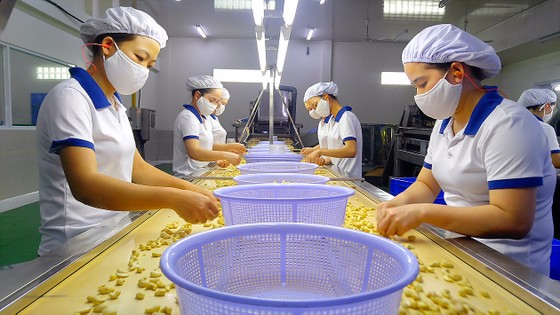(29/1/2018) Vietnam cashew industry “buy near neighbors”
Increase processing, increase imported materials
The benefits of nuts to health are the reason that consumers, especially in developed countries, use increasingly popular cashew nuts, walnuts, almonds, nuts …
Demand for all types of nuts, including cashew nuts, globally is forecast to continue to rise. According to Michael Waring, vice president of the World Council of Dry Seeds (INC), when World Health Magazine published the nutritional content and beneficial effects of many diseases in cashew nuts, this is Seed types are preferred.
The demand for cashew nuts in the world increased about 10% per year, while the increase in area as well as cashew nut production was only 5%. This is a condition for Vietnam’s cashew industry to continue to grow in the coming time. INC dry grain transactions in the global market are valued at about $ 30 billion a year, with the largest market share of about $ 6.5 billion. With this trend, by 2021, cashew nuts will account for nearly 29% of the market, followed by walnut seeds.
However, the higher the amount of processing, the more businesses (DN) to import more raw materials from countries, especially Africa and the highest is the Ivory Coast.
 Cashew kernel inspection – a step in cashew processing technology in Vietnam.Photo: DINH TRUONG
Cashew kernel inspection – a step in cashew processing technology in Vietnam.Photo: DINH TRUONGAccording to the Vietnam Cashew Association (Vinacas), imported raw materials increased gradually through each year. Initially only tens of thousands of tons per year, in 2016 exceeded 1.1 million tons and in 2017 nearly 1.5 million tons. At the press meeting in late 2017, Vinacas Chairman Nguyen Duc Thanh said that domestic raw materials only meet about 20% – 30% of the demand of the plant.
The market of imported raw cashew nuts in recent years shows that dependence on imported raw materials leads to many risks for Vietnamese enterprises. Importers always face the risk of contract cancellation, delivery is not timely, risk in payment.
According to Bach Khanh Nhat, Director of Vina Control, the phenomenon of crude imported from Africa is moldy, sprouting, rotten, many impurities still occur.
The rate of imported raw materials remains high, accounting for 30%. In 2017, there is a phenomenon of rotten cashew nuts, dry outer shell, normal shell color, but inside the kernel rotten or moldy, the rate of recovery is reduced sharply; or darkened kernel, affecting the quality of the kernel after processing. This not only cause material losses but also affect the credibility of enterprises when exporting raw materials.
Construction of raw material zone in Cambodia
Nguyen Duc Thanh said that besides the construction of the raw material zone in the country, when the area was reduced due to the increase in productivity, the association visited some places in Cambodia adjacent to Vietnam and received These areas have similar conditions to the South East (the focus area of domestic raw materials), quite suitable for the growth of cashew.
In fact, Cambodia is one of the countries that produces raw cashew nut with stable quality, thanks to the relatively good varieties. In particular, the Cambodian Ministry of Agriculture, Forestry and Fisheries is interested in growing new high yield cashew trees to increase farmer income.
Therefore, Vinacas is coordinating with the Cambodian Ministry of Agriculture and local businesses, cooperating to build a 500,000 hectare cashew growing area with the hope of having a source of about 1 million tons a year in the future. Vinacas and cashew processing enterprises of Vietnam committed to buy all the raw materials that the Cambodian production.
The Cambodian government’s chief minister of agriculture, agriculture and fisheries, Hean Vann Horn, said the cashewnut area in Cambodia had fallen sharply if production and consumption were good. In cooperation with Vietnamese enterprises, the construction of 500,000 hectares of raw materials in Cambodia in the near future is feasible.
Raw materials from Cambodia exported to Vietnam over 90% in the past two years, while in the previous year only about 30%.Cambodia is currently the fifth largest raw material country after African countries, but Hean Vann Horn said that in order to encourage and attract re-entry of cashew growers, Cooperation between the two sides has been successful. The Cambodian side desires the Vietnam Cashew Association to support and assist (from the selection of seeds, cultivation process, harvesting and preservation techniques) to increase productivity. , quality of cashew nuts, thereby ensuring the life of the profits of Cambodian cashew growers.
They have the phrase “Sell your brothers far, buy close neighbors” fit in this context, when cooperation based on the principle of mutual benefit. Cambodia has a concentrated raw material area, Vietnam has strength in technology and processing equipment.
Transport distance is very close to that of Africa. The Vietnamese cashew industry expects export activities that are too market dependent or raw materials from one country or region to reduce risks. In addition, the consolidation of domestic raw materials will help solve the problem and the raw material supply problem – the key weakness of Vietnam’s cashew industry.
In view of the goodwill, from experience in Vietnam, Vinacas experts recommend identifying seed selection as a priority, followed by cultivation, harvesting and commercial practices. Should choose and propagate right from the best local plants, then planted in that area, rather than hurry to bring foreign seed to plant. Because breeds are genetically and biologically diverse. In addition, Vinacas will support the country with 1.5 billion VND to fund the development of 1 million high yielding seedlings in 2018-2022. A team working on research and development assistance for Vietnam-Cambodia has also been set up to realize this plan.
SESSION
Source: Sai Gon Giai Phong Newspaper
BACK